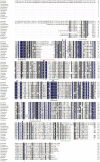Characterization of mannitol-2-dehydrogenase in Saccharina japonica: evidence for a new polyol-specific long-chain dehydrogenases/reductase
- PMID: 24830763
- PMCID: PMC4022671
- DOI: 10.1371/journal.pone.0097935
Characterization of mannitol-2-dehydrogenase in Saccharina japonica: evidence for a new polyol-specific long-chain dehydrogenases/reductase
Abstract
Mannitol plays a crucial role in brown algae, acting as carbon storage, organic osmolytes and antioxidant. Transcriptomic analysis of Saccharina japonica revealed that the relative genes involved in the mannitol cycle are existent. Full-length sequence of mannitol-2-dehydrogenase (M2DH) gene was obtained, with one open reading frame of 2,007 bp which encodes 668 amino acids. Cis-regulatory elements for response to methyl jasmonic acid, light and drought existed in the 5'-upstream region. Phylogenetic analysis indicated that SjM2DH has an ancient prokaryotic origin, and is probably acquired by horizontal gene transfer event. Multiple alignment and spatial structure prediction displayed a series of conserved functional residues, motifs and domains, which favored that SjM2DH belongs to the polyol-specific long-chain dehydrogenases/reductase (PSLDR) family. Expressional profiles of SjM2DH in the juvenile sporophytes showed that it was influenced by saline, oxidative and desiccative factors. SjM2DH was over-expressed in Escherichia coli, and the cell-free extracts with recombinant SjM2DH displayed high activity on D-fructose reduction reaction. The analysis on SjM2DH gene structure and biochemical parameters reached a consensus that activity of SjM2DH is NADH-dependent and metal ion-independent. The characterization of SjM2DH showed that M2DH is a new member of PSLDR family and play an important role in mannitol metabolism in S. japonica.
Conflict of interest statement
Figures








References
-
- Wisselink HW, Weusthuis RA, Eggink G, Hugenholtz J, Grobben GJ (2002) Mannitol production by lactic acid bacteria: a review. International Dairy Journal 12: 151–161.
-
- Hörer S, Stoop J, Mooibroek H, Boumann U, Sassoon J (2001) The crystallographic structure of the mannitol 2-dehydrogenase NADP+ binary complex from Agaricus bisporus . The Journal of Biological Chemistry 276: 27555–27561. - PubMed
-
- Stoop JMH, Williamson JD, Pharr DM (1996) Mannitol metabolism in plants: a method for coping with stress. Trends in Plant Science 1: 139–144.
-
- Yamaguchi T, Ikawa T, Nisizawa K (1969) Pathway of mannitol formation during photosynthesis in brown algae. Plant and Cell Physiology 10: 425–440.
Publication types
MeSH terms
Substances
LinkOut - more resources
Full Text Sources
Other Literature Sources

